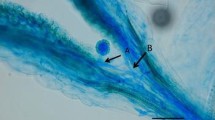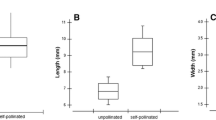Summary
Immersion of Lilium longiflorum pistils in 49 °C water for increasing durations of 1,2,3, or 4 minutes immediately prior to incompatible pollination resulted in a correspondingly progressive decrease in the stylar self-incompatibility competence, as determined from the lengths attained by pollen tubes during 48 hours growth in the styles at 24 °C. Neither pistils remaining on the plant nor those detached from the plant which were immersed after anthesis in 49 °C water for 5 minutes regained self-incompatibility competence during a 48 hour incubation at 24 °C prior to incompatible pollination. Heat treatment of detached pistils as early as 39 hours prior to bud anthesis also resulted in an inactivation of stylar self-incompatibility competence when incompatible pollination was made at 24 hours after anthesis. Experiments utilizing heat treatment of partial lengths of detached whole styles revealed that pollen tubes which have grown through as much at 45 millimeters of either a physiologically incompatible or compatible portion of the style are still capable of shifting to either a higher growth rate or lower growth rate upon entry into respectively either a physiologically compatible or incompatible portion of the style.
Similar content being viewed by others
Literature
Ascher, P.D.: Self-incompatibility in Lilium longifloinm: A. theoretical and experimental approach. Doctoral thesis, University of Wisconsin, Madison, Wisconsin, 1967
Ascher, P.D.; Peloquin, S.J.: Influence of temperature on incompatible and compatible pollen tube growth in Lilium longiflorum. Can. J. Genet, and Cytol. 8, 661–664 (1966a)
Ascher, P.D.; Peloquin, S.J.: Effect of floral aging on the growth of compatible and incompatible pollen tubes in Lilium longiflorum. Amer. Jour. Botany 53, 99–102 (1966b)
Bali, P.N.: Some experimental studies on the self-incompatibility of Oenothera rhombipetala Nutt. Phyton. 20, 97–103 (1963)
Bateman, A.J.: The diversity of self-incompatibility systems in flowering plants. Proc. VIII Int. Bot. Congr. Paris., Sect. 10, 138–145 (1954)
Brewbaker, J.: Pollen cytology and self-incompatibility systems in plants. J. Hered. 48, 271–277 (1957)
Hecht, A.: Partial inactivation of an incompatibility substance in the stigmas and styles of Oenothera. In: Linskens, H.F. (ed.), Pollen Physiology and Fertilization, pp. 237–243, North-Holland Publishing Co. 1964
Hopper, J.E.: Heat and x-ray induced inhibition of self-incompatibility in Lilium longiflorum. Ph. D. Thesis, University of Wisconsin 1970
Hopper, J.E.; Ascher, P.D.; Peloquin, S.J.: Inactivation of self-incompatibility following temperature pretreatments of styles in Lilium longiflorum. Euphytica 16, 215–220 (1967)
Kroh, M.: Reaction of pollen after transfer from one stigma to another (Contribution to the character of the incompatibility mechanism in Cruciferae). Züchter 36, 185–189 (1966)
Myodo, H.: On the pollen tube development and growth of the easter lily (Lilium longiflorum). J. Hort. Soc. Japan 20, 37–43 (1951)
Myodo, H.: Experimental studies on the sterility of some Lilium species. J. Faculty of Agriculture, Hokkaido Univ. L11, 70–122 (1962)
Pandey, K.K.: Evolution of gametophytic and sporophytic systems of self-incompatibility in angiosperms. Evolution 14, 93–115 (1960)
Rowlands, D.G.: Self-incompatibility in sexually propagated cultivated plants. Euphytica 13, 157–162 (1964)
Sears, E.R.: Cytological phenomena connected with self-sterility in the flowering plants. Genetics 22, 130–181 (1937)
Townsend, C.E.: Self-compatibility response to temperature and the inheritance of the response in tetraploid alsike clover Trifolium hybridum L. Crop Sci. 6, 409–414 (1966)
Townsend, C.E.: Self-compatibility studies with diploid alsike clover Trifolium hybridum L. III. Response to temperature. Crop Sci. 8, 269–272 (1968)
Yamada, Y.: Studies on the histological and cytological changes in the tissues of pistil after pollination. Japanese J. of Bot. 19, 69–82 (1965)
Author information
Authors and Affiliations
Additional information
Communicated by H.F. Linskens
Rights and permissions
About this article
Cite this article
Hopper, J.E., Peloquin, S.J. Analysis of stylar self-incompatibility competence by use of heat induced inactivation. Theoret. Appl. Genetics 47, 291–297 (1976). https://doi.org/10.1007/BF00281934
Received:
Issue Date:
DOI: https://doi.org/10.1007/BF00281934




